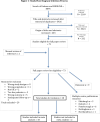Surgical site infection after hip fracture surgery: a systematic review and meta-analysis of studies published in the UK
- PMID: 32922764
- PMCID: PMC7469514
- DOI: 10.1302/2046-3758.99.BJR-2020-0023.R1
Surgical site infection after hip fracture surgery: a systematic review and meta-analysis of studies published in the UK
Abstract
Aims: This study explores the reported rate of surgical site infection (SSI) after hip fracture surgery in published studies concerning patients treated in the UK.
Methods: Studies were included if they reported on SSI after any type of surgical treatment for hip fracture. Each study required a minimum of 30 days follow-up and 100 patients. Meta-analysis was undertaken using a random effects model. Heterogeneity was expressed using the I2 statistic. Risk of bias was assessed using a modified Newcastle-Ottawa Scale (NOS) system.
Results: There were 20 studies reporting data from 88,615 patients. Most were retrospective cohort studies from single centres. The pooled incidence was 2.1% (95% confidence interval (CI) 1.54% to 2.62%) across 'all types' of hip fracture surgery. When analyzed by operation type, the SSI incidences were: hemiarthroplasty 2.87% (95% CI 1.99% to 3.75%) and sliding hip screw 1.35% (95% CI 0.78% to 1.93%). There was considerable variation in definition of infection used, as well as considerable risk of bias, particularly as few studies actively screened participants for SSI.
Conclusion: Synthesis of published estimates of infection yield a rate higher than that seen in national surveillance procedures. Biases noted in all studies would trend towards an underestimate, largely due to inadequate follow-up.
Keywords: Epidemiology; Hip fracture; Surgical site infection.
© 2020 Author(s) et al.
Figures






Similar articles
-
Risk of surgical site infection after hip hemiarthroplasty of femoral neck fractures: a systematic review and meta-analysis.Arch Orthop Trauma Surg. 2024 Aug;144(8):3685-3695. doi: 10.1007/s00402-024-05384-5. Epub 2024 May 28. Arch Orthop Trauma Surg. 2024. PMID: 38805084 Free PMC article.
-
Folic acid supplementation and malaria susceptibility and severity among people taking antifolate antimalarial drugs in endemic areas.Cochrane Database Syst Rev. 2022 Feb 1;2(2022):CD014217. doi: 10.1002/14651858.CD014217. Cochrane Database Syst Rev. 2022. PMID: 36321557 Free PMC article.
-
Does the Risk of Death Within 48 Hours of Hip Hemiarthroplasty Differ Between Patients Treated with Cemented and Cementless Implants? A Meta-analysis of Large, National Registries.Clin Orthop Relat Res. 2022 Feb 1;480(2):343-350. doi: 10.1097/CORR.0000000000001952. Clin Orthop Relat Res. 2022. PMID: 34491939 Free PMC article.
-
Risk of reoperation due to surgical site infection in 74,771 hip fracture patients: a Danish nationwide cohort study.Acta Orthop. 2022 Sep 21;93:760-766. doi: 10.2340/17453674.2022.4580. Acta Orthop. 2022. PMID: 36148617 Free PMC article.
-
Association between operative duration and adverse outcomes after hip fracture surgery: A NSQIP matched cohort study.Injury. 2024 Aug;55(8):111635. doi: 10.1016/j.injury.2024.111635. Epub 2024 May 28. Injury. 2024. PMID: 38852528
Cited by
-
Infection after intracapsular femoral neck fracture - does antibiotic-loaded bone cement reduce infection risk after hemiarthroplasty and total hip arthroplasty?Bone Joint Res. 2023 May 16;12(5):331-338. doi: 10.1302/2046-3758.125.BJR-2022-0314.R1. Bone Joint Res. 2023. PMID: 37191182 Free PMC article.
-
Hip Hemiarthroplasty in Patients with Multiple Myeloma: A Retrospective Case Series and Review of the Literature.Rev Bras Ortop (Sao Paulo). 2025 Jan 16;60(1):1-8. doi: 10.1055/s-0044-1792099. eCollection 2025 Feb. Rev Bras Ortop (Sao Paulo). 2025. PMID: 39831271 Free PMC article.
-
The factors associated with nosocomial infection in elderly hip fracture patients: gender, age, and comorbidity.Int Orthop. 2021 Dec;45(12):3201-3209. doi: 10.1007/s00264-021-05104-3. Epub 2021 Aug 5. Int Orthop. 2021. PMID: 34350473
-
Orthogeriatric co-management for the care of older subjects with hip fracture: recommendations from an Italian intersociety consensus.Aging Clin Exp Res. 2021 Sep;33(9):2405-2443. doi: 10.1007/s40520-021-01898-9. Epub 2021 Jul 21. Aging Clin Exp Res. 2021. PMID: 34287785 Review.
-
Diagnostic accuracy of C-reactive protein to rule out infectious complications following hip fracture surgery.Pak J Med Sci. 2022 Jul-Aug;38(6):1514-1519. doi: 10.12669/pjms.38.6.5577. Pak J Med Sci. 2022. PMID: 35991254 Free PMC article.
References
-
- No authors listed Falls and fragility fracture audit programme (FFFAP): national hip fracture database (NHFD) annual report 2015. Royal College of physicians. 2015. https://www.nhfd.co.uk/nhfd/nhfd2015reportPR1.pdf (date last accessed 5 August 2020).
-
- Cooper C, Campion G, Melton LJ. Hip fractures in the elderly: a world-wide projection. Osteoporos Int. 1992;2(6):285–289. - PubMed
-
- No authors listed Falls and fragility fracture audit programme (FFFAP): national hip fracture database (NHFD) annual report 2018. Royal College of physicians. 2018. https://www.nhfd.co.uk/20/hipfractureR.nsf/docs/reports2018 (date last accessed 5 August 2020).

